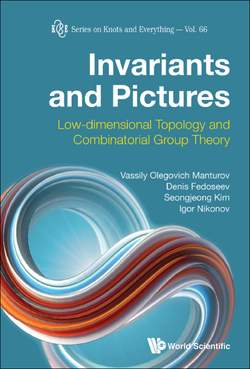Читать книгу Invariants And Pictures: Low-dimensional Topology And Combinatorial Group Theory - Vassily Olegovich Manturov - Страница 15
1.2Small cancellation theory 1.2.1Small cancellation conditions
ОглавлениеWe will introduce the notion of small cancellation conditions C′(λ), C(p) and T(q). Roughly speaking, the conditions C′(λ) and C(p) mean that if one takes a free product of two relations, one gets “not too many” cancellations. To give exact definition of those objects, we need to define symmetrisation and a piece.
As before, let G be a group with a presentation (1.1). Given a set of relations its symmetrisation * is a set of all cyclic permutations of the relations r ∈ and their inverses. A word u is called a piece with respect to if there are two distinct elements w1, w2 ∈ * with the common beginning u, that is w1 = uv′, w2 = uv″. The length of a word w (the number of letters in it) will be denoted by |w|.
Definition 1.7. Let λ be a positive real number. A set of relations is said to satisfy the small cancellation condition C′(λ) if
for every r ∈ * and its any beginning u which is a piece with respect to .
Definition 1.8. Let p be a natural number. A set of relations is said to satisfy the small cancellation condition C(p) if every element of * is a product of at least p pieces.
The small cancellation conditions are given as conditions on the set of relations . If a group Γ admits a presentation S| with the set of relations satisfying the small cancellation condition, then the group Γ is said to satisfy this condition as well.
The condition C′(λ) is sometimes called metric and the condition C(p) — non-metric. Note that always yields C(n + 1).
There exists one more small cancellation condition. Usually it is used together with either of the conditions C′(λ) or C(p).
Definition 1.9. Let q be a natural number, q > 2. A set of relations is said to satisfy the small cancellation condition T(q) if for every l ∈ {3, 4, . . . , q − 1} and every sequence {r1, r2, . . . , rl} of the elements of * the following holds: if , then at least one of the products r1r2, . . . , rl−1rl, rlr1 is freely reduced.
Remark 1.1. Those conditions have a very natural geometric interpretation in terms of van Kampen diagrams. Namely, the C(p) condition means that every interior cell of the corresponding disc partitioning has at least p sides; the T(q) condition means that every interior vertex of the partitioning has the degree of at least q.
Note that every set satisfies the condition T(3). Indeed, no interior vertex of a van Kampen diagram has degree 1 or 2.
